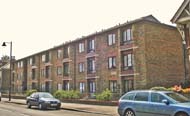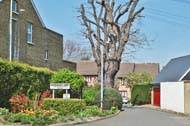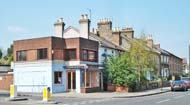Enfield War Memorial Hospital
Chase Side, Enfield, Middlesex
Chase Side, Enfield, Middlesex
Medical dates:
Medical character:
General. Later, GP
The Enfield Cottage Hospital
opened in 1875 as a voluntary hospital with 5 beds. It had been
established by Mr H.C.B. Bowles and other public men at the suggestion
of Dr J. James Ridge (who was also one of the original members of staff
at the Temperance Hospital).
The building was extended in 1887.
During 1897 and 1898 a new ward and an operating theatre were added. The Hospital then had 12 beds.
In 1906 the Hospital was extended again, with the addition of a children's ward.
Following the building of another extension in 1920, the Hospital was renamed the War Memorial Hospital in memory of those who had died during WW1. It had 25 beds.
A new wing was completed in 1926 and was officially opened by Princess Helena Victoria, the Patroness of the Hospital. The new male ward was named 'Princess Helena Victoria Ward' and the new children's ward 'Leggatt Ward' (a 'Leggatt' cot was also endowed, in memory of the Elm House V.A.D. Hospital). Two of the older wards were renamed 'Bowles Ward' and 'J. James Ridge Ward'. (J. James Ridge had died in 1908 and had been succeeded in his general practice and at the Hospital by his son, Robert Leslie Ridge.) The female ward was named 'Pink Ward'. An annexe for children to have their tonsils and adenoids removed also opened, most of the patients being referred by the local education authorities. The Hospital at this time had 53 beds, but plans were made to extend the west end of the new wing after a Mr J. Maitland donated £500.
In 1927, on Dr Howard Distin's retirement as Medical Director, a ward was renamed after him. Repairs were carried out on the Hospital buildings, which were then redecorated externally and internally. Although there was no Out-Patients Department, day cases were treated in the annexe (mainly tonsillectomy and adenoidectomy). A new X-ray room had been built, but the X-ray nurse had left, so the radiologist had to take the X-rays until a radiographer could be appointed. The masseuse also agreed to perform this duty in addition to her usual ones.
In 1927 the weekly cost of an in-patient was £3 2s 11 d (£3.15), in comparison to £2 17s 7d (£2.88) in 1926 and £3 0s 7d (£3.03) in 1925.
Wycliffe, at 5 Gordon Hill, was purchased as a Nurses' Home to house the extra staff needed for the new wards. The house accommodated 7 nurses and 2 domestics. The garden of Wycliffe abutted onto the western boundary of the Hospital - part of it was reserved for convalescent patients, and part for the staff.
On 6th May 1935, along with many other organisations, the Hospital celebrated the Silver Jubilee of King George V. Each patient was allowed to entertain two visitors to tea, the cost of which was defrayed by Enfield District Council, who also paid for the wards to be decorated and a Jubilee Dinner for the staff and patients, as well as a coach drive to London to see the street decorations and the provision of refreshments.
To celebrate the Silver Jubilee, the Enfield Rotary Club gave £22 8s (£22.40) towards the cost of improving the X-ray apparatus. A new auto transformer and timer were purchased, and a tablet was erected in the X-ray Department to commemorate the gift. The sale of the collection of tinfoil raised £9 6s (£9.30). In December a Nurses' Classroom and Recreation Room opened. When not used for study, the room was available for table tennis.
In 1935 the Hospital had 56 beds and discussion began about extending the buildings or rebuilding the Hospital on a new site. The average length of stay of an in-patient was 22 days, and the average weekly cost per patient was £3 6s 4d (£3.32), compared with £3 6s 0d (£3.30) in 1934. The Hospital still had no Out-Patients Department but, during the year, had carried out 613 minor operations and 174 emergency treatments, while discharged in-patients received massage (physiotherapy), electrical and sunlight treatments as out-patients.
The charge for a private room for paying patients was 5 guineas (£5.25) a week, but this did not include the use of the operating theatre - 1 gn (£1.05) - nor expensive drugs, etc. For 3 and a half guineas (£3.67), a screened bed in an ordinary ward (with extra privileges) could be arranged. Fees for professional medical care were extra and agreed separately between the clinician and the patient.
In 1939 the Hospital had 39 beds.
During WW2 it joined the Emergency Medical Service (EMS) with 57 beds, 25 of which were given over to the EMS. In 1941 The Manse in Chase Side was acquired for use as a Nurses' Home. A house in the Hospital grounds, known as The Limes, was vacated and converted into a Board Room and administrative offices. The old offices adjacent to the X-ray Department were then made into a waiting room and dressing room for those awaiting X-ray examination. A Rest Room was also provided for the domestic staff of the Hospital when off-duty.
In 1942 the nursing staff consisted of a Matron, an Assistant Matron, a Sister Tutor and 4 Sisters, 5 Staff Nurses and 15 student nurses. A radiographer had finally been appointed and the masseuse was relieved of that duty. In the same year the sum of £10,000 had been received from the late Mr W. Selby Simpson, which was to be used to build and equip a new wing - to be called 'The Eugenie and William Selby Simpson Wing'.
The Hospital joined the NHS in 1948 with 63 beds under the control of the Enfield Group Hospital Management Committee, part of the North East Metropolitan Regional Hospital Board. Dr Ridge's grandson, Lionel Eric Leslie Ridge, served on the Committee, having been Chairman of the Hospital.
In 1974, following a major reorganisation of the NHS, the Hospital came under the control of the Enfield District Health Authority, part of the North East Thames Regional Health Authority. It had 46 beds.
In 1979 it had 44 beds for acute patients and GP cases.
By 1982 the wards had closed and only an out-patients service survived.
The Hospital closed in 1984, a victim of the government policy of closing hospitals and selling NHS land to housing developers in order to raise funds for the Department of Health.
Present status (April 2008)
The building was extended in 1887.
During 1897 and 1898 a new ward and an operating theatre were added. The Hospital then had 12 beds.
In 1906 the Hospital was extended again, with the addition of a children's ward.
Following the building of another extension in 1920, the Hospital was renamed the War Memorial Hospital in memory of those who had died during WW1. It had 25 beds.
A new wing was completed in 1926 and was officially opened by Princess Helena Victoria, the Patroness of the Hospital. The new male ward was named 'Princess Helena Victoria Ward' and the new children's ward 'Leggatt Ward' (a 'Leggatt' cot was also endowed, in memory of the Elm House V.A.D. Hospital). Two of the older wards were renamed 'Bowles Ward' and 'J. James Ridge Ward'. (J. James Ridge had died in 1908 and had been succeeded in his general practice and at the Hospital by his son, Robert Leslie Ridge.) The female ward was named 'Pink Ward'. An annexe for children to have their tonsils and adenoids removed also opened, most of the patients being referred by the local education authorities. The Hospital at this time had 53 beds, but plans were made to extend the west end of the new wing after a Mr J. Maitland donated £500.
In 1927, on Dr Howard Distin's retirement as Medical Director, a ward was renamed after him. Repairs were carried out on the Hospital buildings, which were then redecorated externally and internally. Although there was no Out-Patients Department, day cases were treated in the annexe (mainly tonsillectomy and adenoidectomy). A new X-ray room had been built, but the X-ray nurse had left, so the radiologist had to take the X-rays until a radiographer could be appointed. The masseuse also agreed to perform this duty in addition to her usual ones.
In 1927 the weekly cost of an in-patient was £3 2s 11 d (£3.15), in comparison to £2 17s 7d (£2.88) in 1926 and £3 0s 7d (£3.03) in 1925.
Wycliffe, at 5 Gordon Hill, was purchased as a Nurses' Home to house the extra staff needed for the new wards. The house accommodated 7 nurses and 2 domestics. The garden of Wycliffe abutted onto the western boundary of the Hospital - part of it was reserved for convalescent patients, and part for the staff.
On 6th May 1935, along with many other organisations, the Hospital celebrated the Silver Jubilee of King George V. Each patient was allowed to entertain two visitors to tea, the cost of which was defrayed by Enfield District Council, who also paid for the wards to be decorated and a Jubilee Dinner for the staff and patients, as well as a coach drive to London to see the street decorations and the provision of refreshments.
To celebrate the Silver Jubilee, the Enfield Rotary Club gave £22 8s (£22.40) towards the cost of improving the X-ray apparatus. A new auto transformer and timer were purchased, and a tablet was erected in the X-ray Department to commemorate the gift. The sale of the collection of tinfoil raised £9 6s (£9.30). In December a Nurses' Classroom and Recreation Room opened. When not used for study, the room was available for table tennis.
In 1935 the Hospital had 56 beds and discussion began about extending the buildings or rebuilding the Hospital on a new site. The average length of stay of an in-patient was 22 days, and the average weekly cost per patient was £3 6s 4d (£3.32), compared with £3 6s 0d (£3.30) in 1934. The Hospital still had no Out-Patients Department but, during the year, had carried out 613 minor operations and 174 emergency treatments, while discharged in-patients received massage (physiotherapy), electrical and sunlight treatments as out-patients.
The charge for a private room for paying patients was 5 guineas (£5.25) a week, but this did not include the use of the operating theatre - 1 gn (£1.05) - nor expensive drugs, etc. For 3 and a half guineas (£3.67), a screened bed in an ordinary ward (with extra privileges) could be arranged. Fees for professional medical care were extra and agreed separately between the clinician and the patient.
In 1939 the Hospital had 39 beds.
During WW2 it joined the Emergency Medical Service (EMS) with 57 beds, 25 of which were given over to the EMS. In 1941 The Manse in Chase Side was acquired for use as a Nurses' Home. A house in the Hospital grounds, known as The Limes, was vacated and converted into a Board Room and administrative offices. The old offices adjacent to the X-ray Department were then made into a waiting room and dressing room for those awaiting X-ray examination. A Rest Room was also provided for the domestic staff of the Hospital when off-duty.
In 1942 the nursing staff consisted of a Matron, an Assistant Matron, a Sister Tutor and 4 Sisters, 5 Staff Nurses and 15 student nurses. A radiographer had finally been appointed and the masseuse was relieved of that duty. In the same year the sum of £10,000 had been received from the late Mr W. Selby Simpson, which was to be used to build and equip a new wing - to be called 'The Eugenie and William Selby Simpson Wing'.
The Hospital joined the NHS in 1948 with 63 beds under the control of the Enfield Group Hospital Management Committee, part of the North East Metropolitan Regional Hospital Board. Dr Ridge's grandson, Lionel Eric Leslie Ridge, served on the Committee, having been Chairman of the Hospital.
In 1974, following a major reorganisation of the NHS, the Hospital came under the control of the Enfield District Health Authority, part of the North East Thames Regional Health Authority. It had 46 beds.
In 1979 it had 44 beds for acute patients and GP cases.
By 1982 the wards had closed and only an out-patients service survived.
The Hospital closed in 1984, a victim of the government policy of closing hospitals and selling NHS land to housing developers in order to raise funds for the Department of Health.
Present status (April 2008)
The Hospital was demolished and its site now contains Borrowdale Court, a modern apartment block with its entrance in Gordon Hill.


The Chase Side facade of Borrowdale Court from the north (left). Signage on the Chase Side frontage (right).


The entrance to Borrowdale Court in Gordon Hill.


The Gordon Hill frontage with perhaps some of the old Hospital wall (left). Chase Side, as seen from the south (right).
(Author unstated) 1908 Obituary. Dr J.J. Ridge. British Medical Journal 1 (2475), 1399-1400.
www.british-history.ac.uk
www.enfield.gov.uk
Return to home page